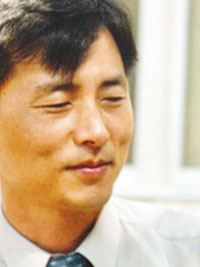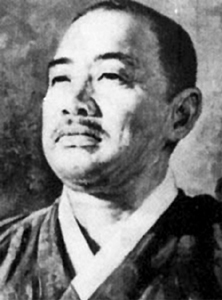
Professor, Dept of Philosophy
The Boy and the Modern Korean Yangming Study Project
The purpose of this study is to examine aspects of modern Korean and Japanese Yangming philosophy through an analysis of the magazine, The Boy, which was published from November 1, 1908 (Vol. 1) to May 15, 1911 (Vol. 2), by Choi Nam-seon (崔南善). This examination will concentrate on the articles published in The Boy, the first modern magazine in Korea, which had ran for three years. Before addressing the primary topic, it will be helpful to provide some information about the magazine, modern academic tendencies, and the main streams of modern Yangming Study first.
In the first issue of the magazine published at 'Sinmunkwan', Choi Nam-seon wrote, "Let boys read this. And let fathers and brothers who teach them also read this." He wanted as many people as possible to read the magazine. Clarification of what is meant by the title, The Boy, is important. "Boy" is not to be interpreted as a male child only but rather is defined as "the young men over 20 years as well as eighteen and nineteen years" roughly those are the same age group of Choi when he published the magazine. The journal of The Youth Association (靑年學友會) by An Chang-ho (安昌浩: 1878-1938) declared that The Boy is representative of his generation.

It is of interest that the magazine was titled "The Boy Korea" (少年大韓) which was adopted from the Chinese style of word order by adding the name of a nation or other nouns after the boy as in The Boy China (少年中國) by Liang Ch'i-ch'iao (梁啓超: 1873-1929) which was popular in East Asia. The word order was originally introduced by a famous Japanese journalist named Tokutomi Soho (德富蘇峰: 1863-1957). Soho was a democrat. He founded Minyosha Publishing Company (民友社) in 1887 and published the National Friend (Kokuminnotomo, 國民の友).
In 1892, he published a newspaper serial from May to September about Yoshida Shoin (吉田松陰) who was a Yangming scholar in the late Shogunate Era. In the series, he wrote about the Italian young men, The Boy Italy, referring to a revolutionary young man of the Italian Nationalist Party founded by Giuseppe Mazzini (1805-1872) who was one of the heroes in establishing Modern Italy. After the series, the practice of putting the name of country after the word "Boy" in the title became popular in East Asia, as in the book The Story of Three Heros on the Establishment of Italy (伊太利建國三傑). Choi Nam-seon also wrote "The Garibaldi Story" (Giuseppe Garibaldi: 1807-1882) for his own magazine. In The Boy Choi tried to capture the spirit of Garibaldi as a symbol of modern revolutionary figures who can achieve a 'modern nation-state.'

The title page of the first number for The Boy
The Story of Master Wang Yang-ming (王陽明先生實記) by Park Eun-sik (朴殷植: 1895-1925) who precipitated the discontinuation of The Boy motivated Choi to accept modern Japanese Yangming Study. After that, Jeong In-bo (鄭寅普) who wrote The Series of Yangming Study (陽明學演論) reconstructed modern Korean Yangming Study.
Choi Nam-seon was born into a middle class family. He contributed to the Hwangseong Newspaper at an early age. In 1902, he entered Gyeongseong Hakdang (primary school) in Seoul and enrolled Tokyo First Middle School in 1904. Three months later, however, he returned to Korea and then was put into prison because of his contribution to the newspaper. In 1906, he entered Waseda University in Japan but quit after involvement in the 'Mock Parliament Incident' in 1907. On his way back to Korea, he carried a printing machine with him, and started working at his brother's publishing company, Sinmunkwan, where he published the first issue for the monthly magazine The Boy on November 1, 1908.
Choi was a first person who accepted the Japanese concept of 'Great West' (泰西) and who introduced it to Korea. He is also credited with the development of a new morphology of the West in Korea even though his ideas heavily derived from the Japanese world-view. His persistent introduction, application of a new way of thinking and his bold acceptance of a new ideology are particularly noteworthy. His typical concepts expressed in The Boy are as follows; "the boy," "morphology," "historical literature," and "Yangming Study."
The very existence of The Boy itself is significant to burgeoning modern Korea in the early 1900s. East Asia lies to the north of the Korean peninsula, while Japan and the 'Great West' are surrounding the remaining three sides of the peninsula. This geographic juxtaposition greatly influenced a new morphology. Choi hoped the younger generations would take a progressive world-view conducive to nation-wide patriotism and enlightenment. The high-spirited images, such as the "sun," "ocean," and "from the sun to boys" in his poetry, are symbols of the new morphology.
Korean historical literature promoted not only a new morphology but also contributed to a rise of patriotism and anti-Japanese imperialism among the Koreans. It fostered longing for heroes as well. Modern Korean intellectuals struggled with or adapted themselves to Japanese imperialism and militarism. They transplanted and/or translated the Western empires known as the 'Great West' into the Great East. The 'Great East' (泰東) is referred to Asia within the spheres of Eastern tradition. Some intellectuals were anxious to build a small empire, while accepting Western morphological consciousness and world-views conducive to the expansion of national territories. To this end, they accepted the war stories of the great men in the establishment of Western empires, and studied the West to educate themselves in Western geography, culture and institutions. This exposure to Western studies accelerated the Eastern enlightenment movement. The logic of Enlightenment was dominant, and the position taken to support Japanese imperialism and militarism swept over Korea. Yangming Study represented in The Boy is closely linked with the three concepts mentioned above; the boy, morphology and historical literature.
The Boy provides an arena of competence for taking in the new waves of knowledge in modern Korea. Specifically, it supplies a variety of 'modern' philosophical ideas and modern Yangming Study which had developed and became popular after Meiji Reform. Though Korean Yangming Study was influenced by the Japanese, ultimately it opposed Japanese Nationalism in the name of patriotic enlightenment. After the Japanese annexation of Korea in 1910, the influx of Japanese 'modernity' and modern Yangming Study into Korea was banned by Japanese policy. The discontinuous publication of The Boy by Japan resulted in the breakdown of the Korean modernity project and modern Yangming Study which had found independent expressions in the magazine.
While little research has been done on the relation between Park Eun-sik and modern Japanese Yangming Study, far less research was done on the contribution of Choi Nam-seon to Yangming Study in Korea. Choi's efforts to develop Yangming Study in The Boy from 1 November 1908 to 15 May 1911 can be regarded as one significant aspect of the development of unique Korean modernity. Choi's contributions to The Boy provide evidence of the progress of modern Korean thought by way of Yangming Study.


